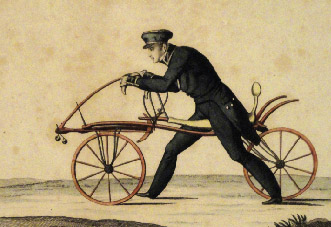Early machines
Published in Issue 1 (January/February 2014), Volume 22
The Draisienne or dandy-horse or hobby-horse—appeared in Ireland in the summer of 1819.
Cycling was a fringe pursuit for most of the period since the first crude form of bicycle, the Draisienne or dandy-horse or hobby-horse, appeared in Ireland in the summer of 1819. For a few months in this year Irish ‘dandies’, like their British and French counterparts, propelled these pedal-less machines around fashionable parks until the novelty of the contraption wore off. In the decades that followed, a few enterprising individuals made their own cycling machines but without sparking off the kind of wider interest that marked the ephemeral craze for dandy-horses. These pioneering individuals included Robert Manley, a Dungarvan farming implement-maker, who in 1843 constructed a form of tricycle with a ‘neat gig-like appearance’, which was ‘propelled by two levers worked pleasantly by the hands and feet’, allowing the rider to travel uphill as well as down. Another early tricycle-making innovator was William Bowden of Ballysallagh, Co. Down, who in 1848 constructed a hand-propelled, foot-steered machine that could be ridden by two riders. Most Irish cyclists before the late 1860s rode either wooden tricycles that they had constructed themselves or wooden quadricycles made in various factories throughout the United Kingdom, including that of a Dublin manufacturer named Andrews.
















